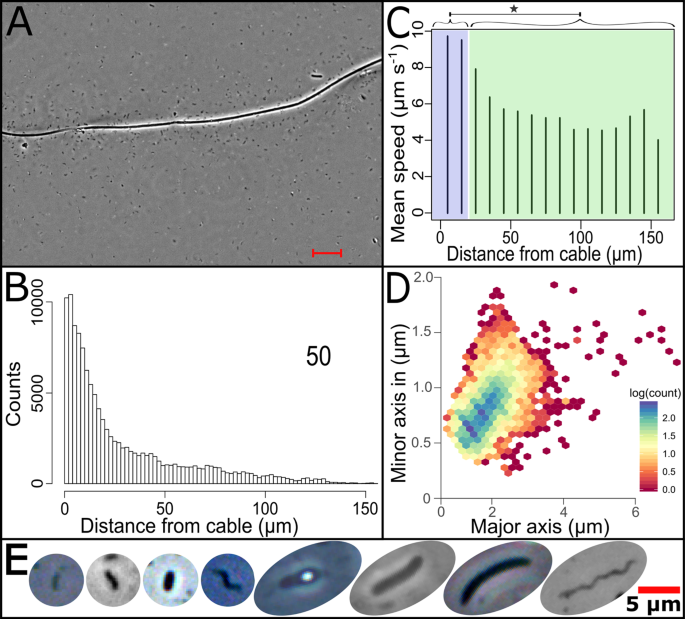电缆细菌与氧气的电连接吸引多种细菌聚集
作者:Jesper J. Bjerg, Jamie J. M. Lustermans, Ian P. G. Marshall, Anna J. Mueller, Signe Brokjær, Casper A. Thorup, Paula Tataru, Markus Schmid, Michael Wagner, Lars Peter Nielsen & Andreas Schramm
期刊:Nature Communications
电缆细菌是一种厘米级长度的丝状细菌,能够通过内部的导线传导电子,从而将深层缺氧沉积物中的硫化物氧化过程与表层沉积物中的氧气还原过程耦合起来。电缆细菌的活性可诱导沉积物中的地球化学变化,其他细菌族群也可能受惠于电缆细菌与氧气的这种电连接。本文报告了多种细菌在电缆细菌呼吸氧气时会密集游动在电缆细菌的缺氧部分周围,并在电缆细菌与氧气连接中断时(通过激光切割电缆细菌)立即分散。拉曼显微镜观察表明,聚集的细菌在靠近电缆细菌时呈现更多的氧化态,但物理接触似乎很少且短暂,这表明潜在的电子转移是通过未知的可溶中间体实现的。宏基因组分析表明,大多数群集细菌似乎是需氧菌,包括有机营养菌、硫化物氧化菌,以及可能是铁氧化菌,它们可能通过将电子传递给电缆细菌进行呼吸。电缆细菌与这些不同伙伴的联系和密切互动可能解释了氧气如何通过电缆细菌影响微生物群落,以及这些需氧微生物进入缺氧环境的过程。
(实习生叶晟晖编译)

Fig. 1 Documentation and main properties of bacterial flocks around cable bacteria.
A Flocking bacteria attracted to a cable bacterium filament (center) (Scale bar, 10 µm). B Counts of swimming bacteria at different distances to the cable bacterium filament (960,071 counts of 3211 flocking bacteria in 12 video frames, mean distance 17.42 µm. The means of the individual samples ranged from 4.96 to 24.58 µm. C Difference in mean swimming speed of bacterial cells relative to their distance to the cable bacterium filament. The shaded blue area corresponds to a distance within 20 µm of a cable bacterium, shaded green to more than 20 µm. Welch’s two-sample t-test (two-sided) shows that the swimming speed of cells is significantly different between these two distance groups (indicated by *); p-value = 2.2e−16 (Nsamples = 11, Ncells = 2712). D Density plot of bacterial cell sizes from all samples (n = 12), showing that the majority of interacting cells is small. E Phase contrast images of the different cell morphologies found. Source data are provided as a Source Data file.
Cable bacteria are centimeter-long filamentous bacteria that conduct electrons via internal wires, thus coupling sulfide oxidation in deeper, anoxic sediment with oxygen reduction in surface sediment. This activity induces geochemical changes in the sediment, and other bacterial groups appear to benefit from the electrical connection to oxygen. Here, we report that diverse bacteria swim in a tight flock around the anoxic part of oxygen-respiring cable bacteria and disperse immediately when the connection to oxygen is disrupted (by cutting the cable bacteria with a laser). Raman microscopy shows that flocking bacteria are more oxidized when closer to the cable bacteria, but physical contact seems to be rare and brief, which suggests potential transfer of electrons via unidentified soluble intermediates. Metagenomic analysis indicates that most of the flocking bacteria appear to be aerobes, including organotrophs, sulfide oxidizers, and possibly iron oxidizers, which might transfer electrons to cable bacteria for respiration. The association and close interaction with such diverse partners might explain how oxygen via cable bacteria can affect microbial communities and processes far into anoxic environments.
Read more
Bjerg, Jesper J., Jamie JM Lustermans, Ian PG Marshall, Anna J. Mueller, Signe Brokjær, Casper A. Thorup, Paula Tataru et al. "Cable bacteria with electric connection to oxygen attract flocks of diverse bacteria." Nature Communications 14, no. 1 (2023): 1614.








